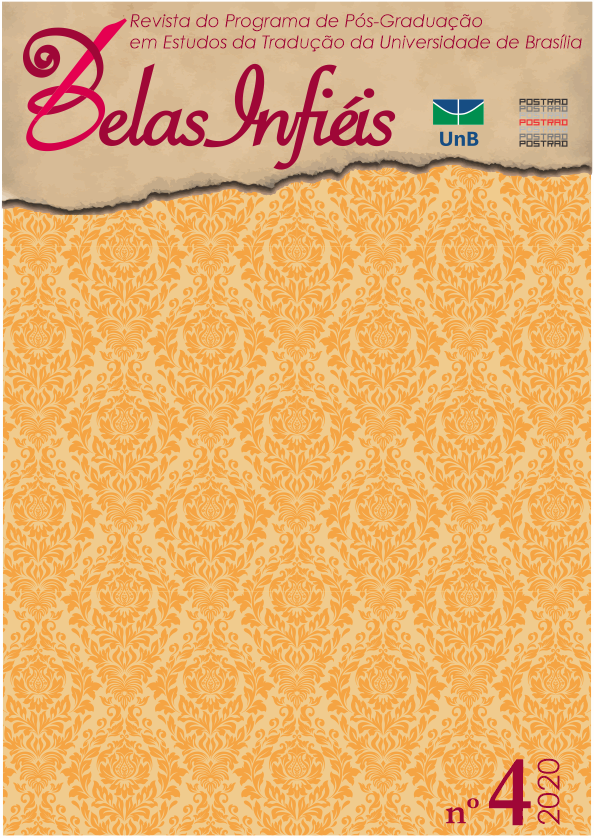Intersemiotic Translation as a Factor in Subtitling Production through Digital Image Processing and Filmic Narrative
DOI:
https://doi.org/10.26512/belasinfieis.v9.n4.2020.26998Keywords:
Intersemiotic translation. Filmic narrative. Digital Image processing. Subtitling. Facial expressions.Abstract
This paper aims to apply digital image processing and information technology to analyze facial expressions of movie characters as an influential factor for the selection of verbal language in subtitling. The corpus used in the study is comprised of scenes selected from the films Magnolia (1999) and Bicho de Sete Cabeças (2001) aiming at: 1) analyzing character construction in filmic narratives through the application of digital image processing techniques, and 2) exploring information technology and digital image processing resources associated with Intersemiotic Translation to analyze images and the construction or omission of subtitles, considering non-verbal language in specific moments of the filmic narrative. To this end, the selected scenes were analyzed building on: triangulation of data obtained through digital image processing via software for facial recognition and emotional quantification (Affectiva, EMOVIE); the analysis of characters inserted in their filmic narratives (GAUDREAULT; JOST, 2009); and the translation choices for subtitles (DÍAZ CINTAS; REMAEL, 2014), considering Intersemiotic Translation as analogic signifying through distinct sign systems (PLAZA, 2003). Results showed that the textual reduction imposed to subtitles does not jeopardize spectatorial comprehension due to their insertion in audiovisual works through the concept of semiotic cohesion (DÍAZ CINTAS; REMAEL, 2014). They also showed that: 1) the human face and facial expressions are relevant in the filmic narrative as complex sign systems (EKMAN; FRIESEN, 2003), and 2) digital image processing and emotional quantification, albeit limited for dealing with filmic context, reveals new possibilities of technological use of software in favor of subtitling and the spectator.
Downloads
References
ANDRADE, Nara Cortês; ABREU, Neander Silva; DURAN, Victor Riccio; VELOSO, Tainã Jesus; MOREIRA, Narena Alencar. Reconhecimento de expressões faciais de emoções: padronização de imagens do teste de conhecimento emocional. Psico, Porto Alegre, PUCRS, v. 44, n. 3, p. 382-390, 2013. Disponível em: http://revistaseletronicas.pucrs.br/ojs/index.php/revistapsico/article/view/15825 Acesso em: 15 dez. 2019.
AFFECTIVA Emotion as a Service. [S.l.]: Affectiva, 2018. Disponível em: https://www.affectiva.com/ Acesso em: 15 dez. 2019.
BANDICAM Screen Recorder. Version 4.1.4.1413. [S.l.]: Bandicam Company, 2018. Disponível em: https://www.bandicam.com/downloads/. Acesso em: 15 dez. 2019.
BANDICUT Video Cutter. Version v3.1.2.441. [S.l.]: Bandicam Company, 2018. Disponível em: https://www.bandicam.com/bandicut-video-cutter/download/. Acesso em: 15 dez. 2019.
BICHO de Sete Cabeças. Direção: Laís Bodanzky. Produção: Sara Silveira, Caio Gullane, Fabiano Gullane, Luiz Bolognesi, Marco Müller. Brasil: RioFilme, 2001.
DEMOS, Bibiane. Reconhecimento de expressões faciais em indivíduos com doença de Parkinson. 2011. Dissertação (Mestrado em Psicologia) ”“ Instituto de Psicologia, Universidade de Brasília, Brasília. Disponível em: https://repositorio.unb.br/bitstream/10482/8776/3/2011_BibianeDemos.pdf. Acesso em: 15 dez. 2019.
DÃAZ CINTAS, Jorge; REMAEL, Aline. Audiovisual translation: Subtitling. UK: Routledge, 2014. doi: https://doi.org/10.4324/9781315759678
EKMAN, Paul; FRIESEN, Wallace V. Unmasking the face: A guide to recognizing emotions from facial clues. United States: Malor Books, 2003.
GAUDREAULT, Andre; JOST, François. A narrativa cinematográfica. Brasília: Editora Universidade de Brasília, 2009.
LEÃO, Leonardo Panta; BEZERRA, Jonas Santos; MATOS, Leonardo Nogueira; NUNES, Maria Augusta Silveira Netto. Detecção de expressões faciais: uma abordagem baseada em análise do fluxo óptico. Revista GEINTEC, São Cristovão, v. 2, n. 5, p. 472-489, 2012. Disponível em: http://www.revistageintec.net/index.php/revista/article/view/73 Acesso em: 15 dez. 2019. https://doi.org/10.7198/S2237-0722201200050005
OPENSUBTITLES.org. Bicho de Sete Cabeças Legendas Inglês. Opensubtitles.org, 2000. Disponível em: https://www.opensubtitles.org/pb/subtitles/4455639/bicho-de-sete-cabecas-en. Acesso em: 15 dez. 2019.
MAGNÓLIA. Direção: Paul Thomas Anderson. Produção: Paul Thomas Anderson e JoAnne Sellar. Estados Unidos: New Line Cinema, 1999.
PEIRCE, Charles Sanders. Semiótica. São Paulo: Perspectiva, 2010.
PLAZA, Júlio. Tradução Intersemiótica. São Paulo: Perspectiva, 2003.
SANTAELLA, Lúcia. O que é Semiótica. São Paulo: Brasiliense, 1983.
SILVA, Andresso; BRANCO, Sinara de Oliveira. Desenvolvimento de software para análise de expressões faciais e emocionais humanas a partir da tradução intersemiótica e processamento digital de imagens. Relatório PIBITI (CNPq). Universidade Federal de Campina Grande, 2018.
SOUSA, Ailton Lopes de; COSTA, Saulo William da Silva; PIRES, Yomara Pinheiro; ARAÚJO, Fabíola. Reconhecimento de expressões faciais e emocionais como método avaliativo de aplicações computacionais. In: ENCONTRO REGIONAL DE COMPUTAÇÃO E SISTEMAS DE INFORMAÇÃO, 2016, Manaus. Anais... Curitiba: 2016a. p. 178-187.
SOUSA, Ailton Lopes de; COSTA, Saulo William da Silva; PIRES, Yomara Pinheiro; ARAÚJO, Fabíola. FOURFACE: Uma ferramenta de reconhecimento de expressões faciais. In: EATI ”“ ENCONTRO ANUAL DE TECNOLOGIA DA INFORMAÇÃO, Ano 6, n. 1, 2016, Frederico Westphalen. Anais... Frederico Westphalen: 2016b. p. 185-192.
Downloads
Published
How to Cite
Issue
Section
License
Copyright (c) 2020 CC BY

This work is licensed under a Creative Commons Attribution 4.0 International License.
Given the public access to this journal, the texts are free to use but requires the recognition of the original authorship and initial publication in this journal to be properly stated.
 The journal allows the use of works published for non-commercial purposes, including the right to submit the work to publicly accessible databases. Published contributions are the sole and exclusive responsibility of the author(s).Â



















